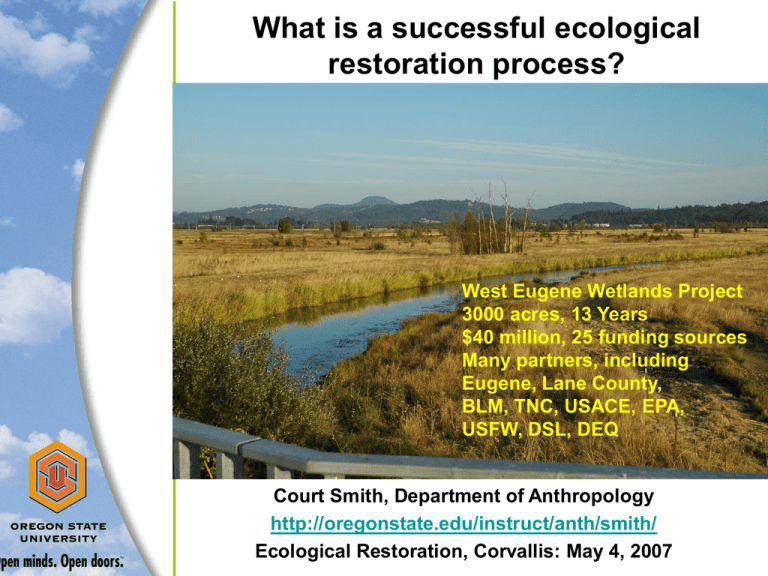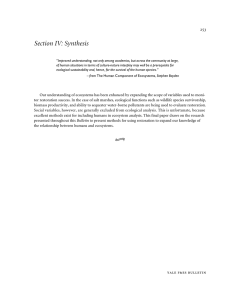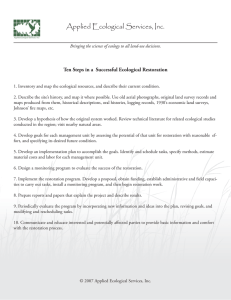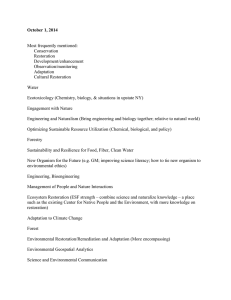Ecological Restoration
advertisement

What is a successful ecological restoration process? West Eugene Wetlands Project 3000 acres, 13 Years $40 million, 25 funding sources Many partners, including Eugene, Lane County, BLM, TNC, USACE, EPA, USFW, DSL, DEQ Court Smith, Department of Anthropology http://oregonstate.edu/instruct/anth/smith/ Ecological Restoration, Corvallis: May 4, 2007 Acknowledgments Support from the National Science Foundation, Biocomplexity in the Environment; EPA Water and Watersheds Program; and Sea Grant Program Thanks to John Bolte Allan Branscomb Lisa Doolittle Chris Enright Jenna Gibson Jennifer Gilden Stan Gregory David Hulse Davis, Hibbits & Midghall Dan Huppert Long Tom WC Marys River WC Andrea Myhre Lisa Nielson PNCERS Bruce Shindler South Santiam WC Brent Steel Interpretations, presentation, associations, confusion, and errors are solely my responsibility. Miracle at 33rd Street M i r a Questions • What is the process to get ecological restoration action? • Where do people get their ecological restoration information about restoration? • What influences the interpretation of ecological restoration information? What US Citizens Know • 40% believe in evolution, dropping from 45%; only Turkey’s % is lower of 34 nations • 13% know what a molecule is • 8th grade math gets a high school diploma in California Source: Kristoff 2005; Miller 2006 Sources of Information Smith et al. 1997 Experiential learning works best for young and old. Can we afford it? • Values, a lens through which we view reality Schematic of Milbrath’s findings representing the US public’s position on the DSP-NEP continuum (From Kempton et al. 1995:200). NEP=New Ecological Paradigm AC=adverse consequences AR=ascription of personal responsibility Dietz et al. 2005:357 Ecological restoration competes with many priorities Connect ecological restoration to many goals Ecological restoration is about land use and land use planning plays a critical role. Values, opinions, attitudes, preferences, desires, beliefs, feelings, intentions are one of the important aspects of ecological restoration processes. Rogers 1995:262 Rogers 1995:258 N u m b e r o f P r o je c t s Willamette Valley Restoration Projects 2000 1500 1000 500 0 1995 1997 1999 Year 2001 2003 What’s this have to do with the restoration process? Culture, Values, and Social Pressures Urban Residents and Non-point Source Pollution: An Examination of Practices, Influences, and Values in the Tualatin Watershed Lisa Nielson The Goal? Source: Scott’s Fertilizer Company (www.scotts.com) Project Design • Agency perspective: – In-depth interviews with water quality and conservation managers – Content analysis of websites and pamphlets • Practices, Influences, Values of Urban Residents – Direct Observations (n=176) – Direct-mail survey (n=98) – Short interviews with residents (n=22) Demographics Survey Population $107-346,000 Residence Total Value Education 57% college grad or higher Income $50-75,000 average Washington County 90% in same range 42% in same range 64% in same range Lawn Observations 50 40 30 June 20 August 10 0 green mono yellow mono green mix yellow mix Fertilizer/herbicide application per year 45 40 35 30 25 Lawn Fertilizer Herbicide 20 15 10 5 0 3 times Twice Once None Lawn watering per week 45 40 35 30 Daily 2-3 times Once Do not water No lawn 25 20 15 10 5 0 Daily 2-3 times Once Do not water No lawn Lawn type and inputs Water 2 or more/wk Fertilize 2 or more /yr Herbicide 2 or more /yr Green, monoculture lawns 33% 34% 24% Yellow mixed lawns 9% 10% 6% Home, pet, automobile characteristics • • • • • • • 99% of respondents recycle 60% compost yard waste 7% compost kitchen waste 61% put pet waste in the garbage 16% change their oil at home 28% wash their cars on the street 15% know that water entering a storm drain goes to the nearest stream Cultural Influences on • Yard Care Priorities “neat” “nice” “clean” “green” “…would you want your yard looking scraggly? Why do you take a bath? It is the same reason.” Influences Include • Neighborhood appearance (65%) – “I think we have a responsibility to our neighbors to keep our yards nice.” • • • • Cost (52%) Aesthetics (personal enjoyment) (46%) Property values (44%) Environment (32%) Sources of Knowledge • Other people (friends, family, store employees, professionals) (95%) • Labels (5%) Judgment Day • Watchful, judgmental neighbors – “Most of my neighbors do an extremely poor job, that guy over there only comes out twice a year!” – “People have been getting better, but most of them have a long way to go.” – Perfect yard = no criticism Conclusions • Average watering, fertilizing, and herbicide use are most likely more than necessary • Most residents use car washes, properly dispose of pet waste, but do NOT understand storm drain-stream connection • Neighborhood appearance and neighbor approval are important, along with property values, costs, time and aesthetics • People get most information by word-of-mouth • Residents tend to consider both economics and environment important Ames Creek 2001 Ames Creek 2003 South Santiam WC – Ames Creek Project /Watershed1 Myhre 2004 Elements of a Process • • • • • • • Leadership Vision Trust Networks Power Capital Knowledge Scientific, technical, legal, and social knowledge is required for restoration success.






